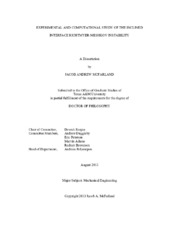| dc.contributor.advisor | Ranjan, Devesh | |
| dc.creator | Mcfarland, Jacob Andrew | |
| dc.date.accessioned | 2013-12-16T20:16:47Z | |
| dc.date.available | 2015-08-01T05:48:22Z | |
| dc.date.created | 2013-08 | |
| dc.date.issued | 2013-08-12 | |
| dc.date.submitted | August 2013 | |
| dc.identifier.uri | https://hdl.handle.net/1969.1/151379 | |
| dc.description.abstract | A computational and experimental study of the Richtmyer-Meshkov instability is presented here for an inclined interface perturbation. The computational work is composed of simulation studies of the inclined interface RMI performed using the Arbitrary Lagrange Eulerian (ALE) code called ARES. These simulations covered a wide range of Mach numbers (1.2 to 3.5), gas pairs (Atwood numbers 0.23to 0.95), inclination angles (30° to 85°), and explored various perturbation types (both inclined interface and sinusoidal). The computational work included the first parametric study of the inclined interface RMI. This study yielded the first scaling method for the inclined interface RMI mixing width growth rates. It was extended to explore the effect of perturbation linearity and identified that a sharp transition in growth regimes occurs for an initial perturbation inclination angle of 75° with angles below (above) this growing faster (slower).
Finally a study of the effects of incident shock strength on the refracted shock wave perturbation decay rate is presented. This study examined how the perturbations induced on the transmitted shock front by the RMI decay with time and found that the decay rates follow a power law model, Alpha=Beta∗S^(Epsilon). When the coefficients from the power law decay model were plotted versus Mach number, a distinct transition region was found which is likely a result of the post-shock heavy gas velocity transitioning from the subsonic to supersonic range.
The experimental portion of this work was conducted using the TAMUFMSTF, completed in May of 2012. This facility uses a variable inclination shock tube, with a modular construction design for incident shock strengths of up to Mach 3.0. It employs optical systems for measuring density and velocity fields simultaneously using the planar laser induced fluorescence and particle imaging velocimetry techniques. The design and construction of this facility is reviewed in detail in chapter 4 of this work.
The initial experiments performed in the TAMUFMSTF provided the first known extensive experimental data for an inclined interface RMI. Planar laser Mie scattering images and velocity vectors were obtained for a N_(2)/CO_(2) interface at a 60° inclination angle and an incident shock strength of Mach 1.55. These images have been compared with simulations made using the ARES codes and have been shown to have some distinct differences. Some of these differences indicate that the initial conditions in the experiments deviate from the ideal planar interface. Other differences have revealed features which have not been resolved by the simulations due to resolution limitations. | en |
| dc.format.mimetype | application/pdf | |
| dc.language.iso | en | |
| dc.subject | Richtmyer-Meshkov instability | en |
| dc.subject | Shock tube | en |
| dc.subject | hydrodynamic instabilities | en |
| dc.subject | Computational Fluid Dynamics | en |
| dc.subject | Experimental design | en |
| dc.title | Experimental and Computational Study of the Inclined Interface Richtmyer-Meshkov Instability | en |
| dc.type | Thesis | en |
| thesis.degree.department | Mechanical Engineering | en |
| thesis.degree.discipline | Mechanical Engineering | en |
| thesis.degree.grantor | Texas A & M University | en |
| thesis.degree.name | Doctor of Philosophy | en |
| thesis.degree.level | Doctoral | en |
| dc.contributor.committeeMember | Duggleby, Andrew | |
| dc.contributor.committeeMember | Pettersen, Eric | |
| dc.contributor.committeeMember | Adams, Marvin | |
| dc.contributor.committeeMember | Bowersox, Rodney | |
| dc.type.material | text | en |
| dc.date.updated | 2013-12-16T20:16:47Z | |
| local.embargo.terms | 2015-08-01 | |


